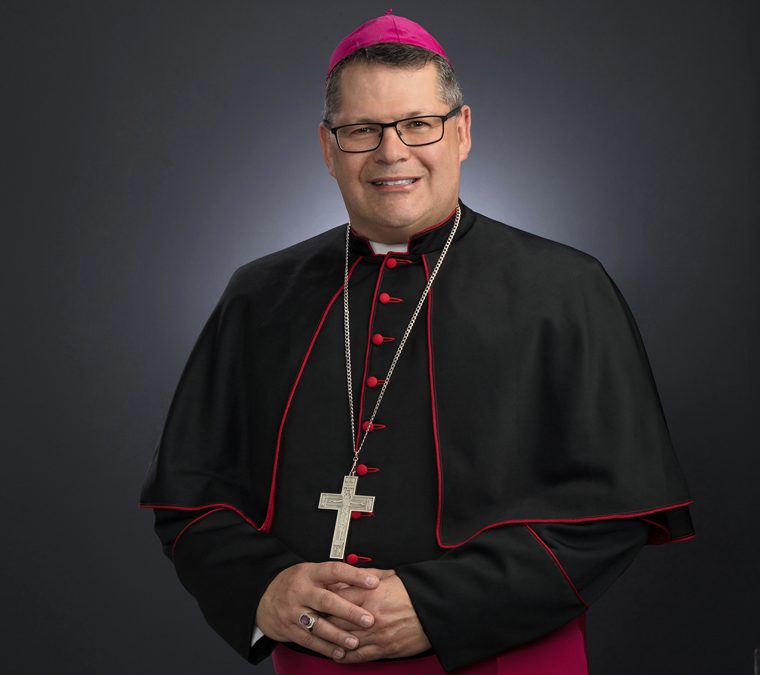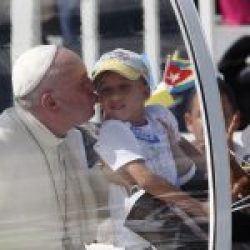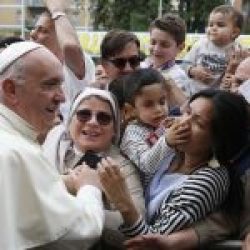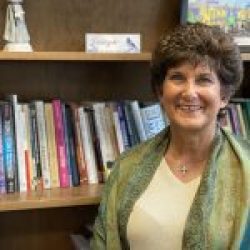Last week, it was a privilege for me to be at Maryknoll and accompany the brothers and priests who live there in reflecting on the theme, “A Living Gospel for All People to Hear.” To walk the hallowed grounds of a place I had seen pictures of since my boyhood, to actually celebrate Holy Mass in its chapel dedicated to “Mary, Queen of the Apostles,” and to meet some of the missionaries themselves whom I had read about was a great privilege. To a large extent it was in this place through the vision of Fr. James A. Walsh (later “Bishop), a diocesan priest from Boston, and Fr. Thomas F. Price, a diocesan priest from Wilmington, N.C., that the missionary effort of the Catholic Church in the United States was founded with the blessing of Pope St. Pius X in 1911 under the title of “Catholic Foreign Mission Society of America.”
On Saturday, I had the additional privilege of joining the Sisters of St. Francis of the Neumann Communities to commemorate the 10th Anniversary of the Canonization of St. Marianne Cope at Assumption Church in Syracuse. Two weeks earlier, I was at the Shrine of St. Kateri Tekawitha to mark the same anniversary. Again, in both celebrations I reflected on both Marianne’s and Kateri’s lives as “a living gospel” for the people of their day. How they became the very “enfleshment” of the Gospel of Jesus Christ, “The Word became flesh and dwelt among us” (Jn 1:14).
The aforementioned moment in salvation history is the center point of our profession of faith as Christians: “And by the Holy Spirit was Incarnate of the Virgin Mary.” As Bishop Robert Barron notes in his work on the Nicene Creed, Light from Light: A Theological Reflection on the Nicene Creed (Park Ridge, IL: Word on Fire Academic, 2021), it is the continuing sweep of the Spirit of God as God’s agent which empowers God’s Word to become known through creation itself, prophets (witnesses), and ultimately in the Word taking on flesh in the womb of the Virgin Mary (see pp. 63-71). As he notes, “The ‘wind from God’ is the ruach Yahweh, often rendered as the ‘spirit’ of God, and his ‘sweeping’ or ‘hovering’ over the surface of the deep carries in the Hebrew the sense of a mother bird beating her wings over her young encouraging them to fly” (p. 63).
Mary, Mother of the Savior and of the Church, teaches us through her own life that how all this can be is through the overshadowing of the power of the Most High, that is, the Holy Spirit. In turn, that same “hovering” Spirit invites us, like Mary, to open our lives to God’s Word — “Do whatever he tells you” (Jn 2:5). Such a response is how you and I become “Christ-bearers” and the bearers of the Good News he brings in today’s world. Even when you and I feel like empty stone water jars or very ordinary like plain ’ole water, the Incarnation teaches us by our willingness to be open to God that is where miracles begin!
This is the universal call to holiness that is the very heart of the Vatican II Dogmatic Constitution on the Church. All men and women are called to holiness wherever they find themselves in life. Such holiness’ foundation is Jesus himself and its fullness is seen in the exercise of Christian charity. So what is holiness … what does it mean to be holy? In his Letter to the Colossians, St. Paul writes: “To live in a manner worthy of the Lord, so as to be fully pleasing, in every good work bearing fruit and growing in knowledge of God, strengthened with every power, in accord with his glorious might, for all endurance and patience, with joy giving thanks to the Father who made you fit to share in the inheritance of the holy ones in light. He delivered us from the power of darkness and transferred us to the kingdom of his beloved Son, in whom we have redemption, the forgiveness of sins” (1:10-14).
One of my favorite stories concerning All Saints Day, which we will celebrate next Tuesday, November 1st, is one about a little boy who was making a visit to the local church with his grandmother. He was in awe of the size and beauty of the church. He pointed to the statues of Mary and Joseph, as well as Jesus on the cross. He looked at the story being told in the Stations of the Cross plaques on the wall. His grandmother pointed to the sun-filled stained glass windows and asked him who those people were. He proudly spoke up and said, “Why, Grandma, those are the ones who let God’s light shine through them!” In a nutshell, isn’t that what it means to be a living Gospel for all people to hear — to enflesh God’s Word today?
When I was at Maryknoll, I became acquainted with the fact that a knoll was not only a small hill or mound, but it is also the sound of a bell calling out. Consequently, we whom St. Paul announces to be God’s saints now (Phil 1:1, Col 1:2, Eph 1:1), are being called in the present moment to rise up in the midst of the present generation and be the Living Word of God’s love and redemption to others.
What a way to end the month of October in which we celebrate the dignity and sanctity of all human life, along with our mission as God’s sons and daughters! But also, what a way to enter the month of November dedicated to all of God’s saints — in the end, God wants our final destiny to be that of sharers in the Resurrection and a place in the Kingdom of God. Even more, it will be in a short time that we again focus on the Incarnation of the Lord in the Advent and Christmas seasons. What better way to prepare than to reflect upon how it fits in God’s plan for you and me here and now!
A lot to think about, so let me end with a quote from Pope Francis which I hope helps put it all into perspective: “In evangelization, the example of a Christian life and the proclamation of Christ are inseparable. One is at the service of the other. They are the two lungs with which any community must breathe, if it is to be missionary.” And what is “missionary?” None other than being a living Gospel for all people to hear! Happy coming feast day of the Saints!







